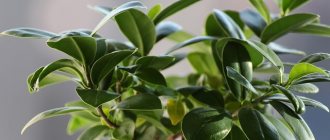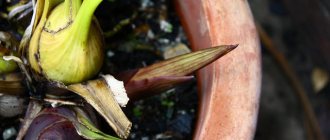How to grow ficus benjamina at home
Growing ficus benjamina is not easy. This plant comes from tropical countries, so it loves moist air, bright light and warmth.
Despite its demanding conditions, Benjamin's ficus (Ficus Benjamina) is very popular because of its beauty.
It grows up to one and a half meters in height, forming a lush tree, the trunk and branches of which are completely covered with small white-green leaves. The Starlight variety has especially many white spots
. The shape of ficus leaves is similar to cherry leaves, only without teeth along the edges.
How does ficus benjamina propagate?
Ficus benjamina can be propagated by cuttings, air layering or seeds. The first two methods are vegetative, which is cloning, when the daughter plants are no different from the mother plant. They are also the simplest. Inexperienced indoor flower lovers can easily cope with cuttings.
How do you propagate ficus benjamina
Cuttings
93.14%
Air layering
6.86%
Growing ficus from seeds is an unreliable business. Even if they have good germination and hatch, it is not easy to bring the seedlings to the state of an adult plant. This is how Benjamin varieties are obtained, which cannot be propagated vegetatively.
Cuttings
Propagation by cuttings is the easiest way to propagate ficuses, and not necessarily those belonging to the Benjamin species. This is how Lyre-shaped, Binnendiyka (Ali), Dwarf, Rubber-bearing and others are cloned.
From one ficus, several seedlings are immediately obtained, all similar to the mother bush. They develop quickly, and within a year they will become independent plants.
Cuttings can be taken in the spring during formation, a branch can be specially cut for this purpose, or a small shoot can be discreetly plucked from the inside of the crown. Not all shoots root equally:
- It is unlikely that it will be possible to propagate ficus benjamina with green cuttings - they will most likely rot in the ground or water;
- cuttings of old, well-lignified stems are reluctant to produce roots, they must be treated with stimulants and specially damage the bark;
- Ficus benjamina is most easily propagated by cuttings taken from last year's branches.
Not only the tops of the stems take root well, but also the middle part. Of course, if she didn’t have time to grow old very much.
How to properly cut shoots
The easiest way to propagate ficus is by cuttings 12-15 cm long. Those that are shorter are more likely to rot. Too large ones produce new roots worse; when planted in a substrate, they become unstable and often fall, turning out and breaking off barely emerging shoots. They must first be germinated in water.
When cutting, the cut is made approximately 0.5 cm below the node, at an acute angle directed towards the bud. The top one (if there is one) should be straight, located at the same distance above the leaf.
You need to work with sterile sharp instruments so that the wound surface is smooth. Make the cut confidently.
Combined cuttings
The most reliable way to propagate Ficus Benjamin. There are two types of cuttings:
- With a heel - a small shoot is taken whole, with a piece of bark and wood from a branch of a higher order. It is not cut off, but neatly torn off. Do not root in water, perlite, peat-sand or other mixture, but immediately plant in light soil. If the cuttings are properly cared for, the survival rate is close to 100%.
- Propagating a plant with a crutch is not much more difficult. This is a small piece of a not too thick branch with a young shoot growing on it perpendicularly. It looks like a small hammer with a thin leafy handle.
The only drawback of the method is the limited amount of planting material. The first method is most often used for woody ficuses - Ali (Binnendijka), Benjamin. The second is more suitable for propagating species with a lush green stem - Lyre-shaped, Rubber-bearing.
Preparing for rooting
To successfully propagate the plant and prevent the branches from rotting, first tear off all the lower leaves. Moreover, not only those that will be immersed in water or substrate, but can also come into contact with them.
It is impossible to remove all vegetative organs; at least 4-5 leaves must remain on the top of the Benjamin ficus for successful photosynthesis and other physiological processes. Then the milky juice is removed. To do this you can:
- immerse the sections in water for 10 minutes;
- keep the shoot under running water at room temperature until the white liquid stops secreting;
- Blot the wound surfaces repeatedly with a clean cloth or cotton swab.
Then the cuttings, ready for rooting, are left for 30-60 minutes in a place protected from direct sunlight with good air circulation. During this time, the wounds should dry out and callus should form.
Thus, the root-forming ability of the branches with which Benjamin's ficus is going to be propagated is significantly increased. And the likelihood of rotting decreases.
When cutting old shoots, it is recommended to make several cuts in the lower part and use root formation stimulants.
Air layering
Any indoor plant with a woody stem can be propagated by air layering. The method is not as simple as cuttings; it requires detailed analysis.
In this way, you can propagate an old ficus with a weak shoot-forming ability, or when they are going to remove a thick branch anyway next season. Growing some types of bonsai is greatly simplified.
Step-by-step instructions on how to propagate Ficus Benjamin correctly by air layering:
- On a well-wooded, not too thin branch, some of the leaves are removed.
- Carefully make two circular cuts so as not to damage the wood.
- Remove the bark between them.
- Blot the milky juice.
- Dust with Kornevin or another drug with a similar effect.
- Wrap it in wet sphagnum moss. You can soak it not with water, but with a solution of a root growth stimulator.
- Wrap with film.
- Secure both ends with wire, thread or other convenient method. Scotch tape is not recommended.
- Sphagnum moss is kept moist. If necessary, open one of the edges and pour in a little liquid, or pierce the film with a syringe filled with water.
- When the roots of the ficus benjamina become clearly visible through the cellophane, the moss is well entwined, the shoot is cut off, and the wrapper is removed.
- The transplant is done together with sphagnum - it will not interfere with the plant.
- The wound surface on the uterine ficus is treated with crushed activated carbon or garden pitch.
Sphagnum is a precursor to acidic peat. It has antiseptic properties and is able to protect the shoot from rotting caused by waterlogging.
Ficus benjamina branches located perpendicular to the surface of the pot can be propagated by layering without wrapping with film. As you can see in the photo, for this purpose they use cut and re-attached plastic cups with a hole in the bottom. They are filled with sphagnum moss and watered as needed so that the moss is constantly wet. This simplifies maintenance - there is no need to unwind the film, and it is easier to control humidity.
Leaves
It is impossible to propagate ficus with leaf blades - they simply do not contain the genetic material necessary for the formation of a full-fledged plant. The authors of articles claiming the opposite do not understand what they are writing about, and bloggers showing vegetative organs immersed in the substrate are outright lying. If the leaf of Ficus Rubber can still give roots, then Benjamin will not do this either due to its small size and finer texture - the plates will dry out or rot earlier. The video is dedicated to the germination of Elastica leaves: Rooted vegetative organs that are not capable of becoming a full-fledged bush or tree are called fun plants. Particularly popular in this capacity are variegated schefflers - their leaves look like an outstretched palm, and live in a small pot for up to 3 years.
Seeds
Among the ways to propagate ficuses, including Benjamin, this is the most unreliable. Seeds lose germination quickly, cannot be produced at home, and come mostly from tropical countries. Beginning flower growers should not undertake such breeding. Sowing is done in a mini-greenhouse, where high humidity and a temperature of 25-28° C are maintained until the sprouts appear. The seeds are treated with a stimulant, laid out on the surface of a moistened substrate, and covered with film or glass. After the emergence of seedlings, intensive lighting is provided, they are gradually accustomed to open air and the temperature is reduced to 20-22 ° C. In the phase of 2-3 true leaves, they are picked out in individual cups.
Even if the ficus benjamina seeds germinate, it will take some work to turn the seedlings into adult plants. Not everyone will survive.
How to grow ficus benjamina
The most affordable option to become the owner of a charming variegated plant is to purchase it at a flower shop. Young Benjamin ficuses are inexpensive and are always on sale. Those who are interested in growing an evergreen exotic “from scratch” can try to propagate it at home using the vegetative or generative method.
From seeds
To grow ficus from seeds,
it will take time and patience. Seeds take a long time to germinate, seedlings grow slowly.
Sowing technology:
- buy several seeds at the store;
- soak them for a day in a solution of Epin or Humate to increase germination;
- sow in soil prepared from garden soil diluted with peat and sand (hole depth 0.5 cm);
- fill the holes with the seeds lying on the bottom with coarse sand;
- pour with warm, settled water;
- cover with film or glass;
- open the vessel daily for 15 minutes for ventilation;
- maintain temperature 23-25 °C;
- with the appearance of sprouts, increase the ventilation time to 2 hours a day;
- when all the seeds have sprouted, the film can be removed;
- place the seedlings in diffused sunlight and illuminate them with fluorescent lamps in winter;
- with the appearance of the first leaf, pick the seedlings into separate pots, removing the weakest specimens;
- In new pots, make a thick drainage layer of broken brick or expanded clay.
Seedlings should be kept in an eastern or western window and ensure that the soil does not dry out too much. Fertilize once every 2 weeks with complex fertilizer for decorative foliage.
From a shoot or twig
To propagate by cuttings, you need to cut a branch about 15 cm long. It should have 4 leaves. The cuttings are cut with a sharp knife so that the cut area is smooth and not wrinkled. The optimal time for rooting cuttings is early spring.
You will need any root growth stimulator:
The listed drugs are sold in gardening stores. Heteroauxin is considered the most effective.
Rooting technology:
- place the freshly cut stalk in water so that
the milky juice comes out of the branch - remove the bottom pair of leaves, leaving the top ones;
- place the cuttings in a growth regulator solution;
- maintain the time recommended in the instructions;
- plant at an angle of 45 degrees in a loose, light substrate so that the cuts from the lower leaves are underground;
- pour, put any transparent lid on the container;
- keep at air temperature +20 °C.
Roots form within 3-4 weeks. When their length reaches several centimeters, the seedling can be transplanted into a permanent pot.
How to plant ficus benjamina so that the stems intertwine
with a wicker trunk from several ficus plants
.
To do this, in the spring, when houseplants are replanted
, two or three young plants of the same height are planted in a pot. If you plan to create a spiral, 2 copies will be enough, for a braid you will need 3 plants about 15 cm high. The stems are braided, tied with soft woolen thread. Every two months the binding must be removed and done in a new place, otherwise the stems will be damaged.
Young shoots that have not yet begun to lignify and are held together with a bandage subsequently retain the shape given to them. The complete formation of ficus takes several years.
Step-by-step instructions: how to propagate and plant?
There are many types of ficus, but they all reproduce equally easily, which makes the procedure easier for gardeners at home.
There are four options in total :
- Leaf.
- Seeds.
- By cuttings.
- By layering.
Each method has characteristic features.
How is it propagated by leaves?
A new leaf plant is grown from large leaves of the highest quality.
- Two cuts are made: the main one and the oblique one, so that the roots develop faster.
- We wash the leaf with water or soak it to remove unnecessary juice, otherwise the process of root formation will be delayed.
Reference! In order for the leaf to quickly turn into a plant, it is better to treat the cut with a special stimulator for the formation of roots. - Before planting, we prepare the pot and soil: we lay drainage at the bottom, lay the soil, adding a little sand and an additive: the mineral wilmeculite. The container must have a hole to drain excess water.
- We carefully twist the leaf and tie it with thread, deepening it shallowly into the soil.
After 3 or 4 weeks, the shoot will take root in the soil, and the air temperature should not be lower than 27 degrees.
You can learn how to propagate ficus with leaves in this video:
Seeds
This is the most difficult method of propagation ; the necessary seeds must be purchased in the store.
It is impossible to grow ficus from homemade seeds, since these are inflorescence berries, which beginners can mistake for seeds.
- Before sowing, the seeds must be treated with a “Fungicide” composition to get rid of fungus and spores, as well as a growth stimulator.
- For soil, it is better to use a mixture of peat and peat moss, or a mixture of humus and sand in a two to one ratio. Before planting seeds, the soil must be disinfected with steam for sterilization.
- It is better to choose a flat container for planting; it can be easily covered with film and it will be easier to monitor the germination of seeds in it. Place the soil in a bowl, press it lightly and spray it; there is no need to water it.
- We place the seeds on moist soil at a short distance from each other so that there is no lack of lighting.
- We maintain the temperature at 23-24 degrees, avoiding direct sunlight. We cover the container with film, which we regularly open for ventilation. It is possible to use glass instead of film; this is more convenient when the seeds germinate and it will be necessary to accustom them to room air and temperature.
- Spray the soil during germination to keep it slightly moist. First, the seeds will take root, then they will germinate and shoot leaves will appear. When there are three or more leaves, they can be transplanted into a common container for further development at a short distance from each other.
Here you can learn about growing ficus from seeds:
Cuttings
This is the simplest method, which is suitable for plants older than two years ; this method can injure a young plant. The future cutting is cut from the top of the plant to a length of ten to fifteen centimeters.
Attention! If the seedling is large, you can use lateral shoots, but the cutting must have at least three leaves.
Too many leaves are undesirable , four to five pieces are enough, excess leaves must be carefully removed.
- We make the cut at an angle to make it easier for the shoot to absorb moisture.
- After cutting, you need to rinse it from the juice with warm water, let it dry and make a cross-shaped notch at the bottom for faster appearance of roots.
- We place the cuttings in a container with water in a warm place for 3-4 weeks; after the roots and young leaves appear, the plant is ready for replanting.
- Next, we plant it in soil made of peat and sand, spray the leaves, and water the plant itself.
- During the first week we cover it with a plastic cap to maintain the temperature above 24 degrees, then carefully accustom it to room conditions.
Watch a video on how to root ficus cuttings in water and then plant them in pots:
Below is a video about how to root cuttings in the ground:
By layering
- We select a shoot at least 50 cm long and cut off the leaf, then use a sharp blade to make a light cut without damaging the plant bark.
- Use cotton wool to remove the juice, and place a match or toothpick into the cut to allow oxygen to enter.
- We wrap the very place of the incision with a layer of moss, which we secure with cling film, while leaving access to oxygen.
Reference! After 15-25 days, roots will appear and develop, after which the seedling can be cut from the mother plant and transplanted into the ground.
Video about propagation by layering:
Caring for Ficus Benjamin
Ficus benjamina feels good in bright but diffused light. Direct sunlight leaves burns on the leaves, makes them faded, and the plant loses its decorative effect. In summer, the temperature should not rise above + 25 °C. In extreme heat, the tree sheds its leaves, as well as when there is a lack of light. In winter, it is enough to maintain the room temperature at +17 °C.
Ficus benjamina likes frequent spraying. Moisture protects leaves from spider mites, washes away dust, and prevents leaf fall, which indicates unsuitable living conditions.
Plants are watered regularly, more often in summer than in winter. If water has accumulated in the pan, it must be drained immediately - the roots of the Benjamin ficus do not tolerate dampness. If the soil dries out, the plant will immediately shed some of its leaves to reduce evaporation. Therefore, when choosing a watering mode, you should adhere to the rule - take up the watering can when the top layer of the earth dries out, but there is still moisture in the depths.
Feeding is carried out every 2 weeks, in winter once a month. Suitable fertilizers :
- Agricola for ficus;
- Bona forte for ficus and palm trees;
- “Flower paradise” for ficus yucca and dracaena.
If the plant begins to shed its leaves, you need to move it closer to the window or, vice versa, remove it from the draft. Check the room temperature and soil moisture in the pot. If the soil is dry, the ficus should be watered first with clean water, and then with fertilizer diluted in water. After some time, the tree will restore its decorative appearance.
Who is this plant suitable for?
Indoor
Ficuses reach a significant size, so they are suitable for owners of spacious rooms. The plant is used for landscaping bright offices, shopping centers, and lobbies. An adult bush can be kept in the back of the room, a few meters from the window.
There are signs associated with this type of ficus. Esotericists note its beneficial effect on the psychological situation in the family. Ficus is a real symbol of home comfort. It improves the energy of the home and increases the comfort of everyone in the room. In its homeland, it is considered a sacred plant that brings good luck and happiness.
Ficus benjamina is a beautiful, popular plant, but it requires care and regular maintenance. It perfectly decorates the interior, suitable for apartments and public spaces.
Propagation of Ficus Benjamin by cuttings
If you decide to use this method of plant propagation, you should follow the following algorithm; you can watch the video below for more details:
- We cut branches from the top of the tree 10-15 cm long. We make the cut obliquely. The prepared cuttings should have 2-3 tiers of leaves.
- When you cut the shoot, a white milk will appear; wash it off with water, since dried juice can interfere with the full development of the roots. It is also possible to place the cut cuttings in a container with water; the water must be changed every 2-3 hours until the liquid stops coming out of the cut, then dry it for an hour.
- Place the dried sprout in a jar of water. You need to make sure that the water is at room temperature; in warm water the branch will sprout roots faster.
- We place our plant in a lighted place, but without direct sunlight. We monitor the evaporation of the liquid, add the missing one.
Make sure that the leaves of your future tree do not touch the water, otherwise it may begin to rot. We also recommend adding a tablet of activated carbon to the water, it will also help prevent rotting.
If the conditions are not met, you may get an effect like in the photo below. The sprouts sprouted roots, but they could not be saved, the stalk began to rot, and the leaves fell off (the reasons for the falling leaves can be found here), since they were completely in water.
After the roots in the water have reached about 5 cm in length, it is time to transplant the sprout into a pot for further cultivation. For faster growth, you can treat the lower part of the seedling with a special root stimulator. [ads-pc-1]
Ficus - growing from seeds at home
Ficus - growing from seeds at home
Ficus trees have been cultivated for centuries as decorative indoor plants, once decorating palace winter gardens and window sills of cheap hotels. Nowadays, it’s rare that a self-respecting office can do without a stylish flowerpot with a luxurious evergreen tree or an exotic ficus in the bonsai style (more often it’s a ficus blunted, on whose powerful aerial roots the side branches rest). And in home collections you can find several varieties of the popular Benjamin series.
In flower salons you can purchase the coveted bush of Sacred Eden or rubber-bearing ficus - retail chains offer a huge selection of varieties, selling both very young plants and decorated adult specimens. It is very easy to grow a tree from a cutting. But among flower growers there are many gambling lovers who prefer to experience the entire development process from the very beginning - from sowing the seed.
We propagate ficus in the ground
There is another way to propagate ficus using cuttings at home - planting cut branches directly into the ground. To do this, you need to select a special mixture of soil that young ficus plants love. If you want to make the mixture yourself, for this we take in equal parts:
- peat soil;
- sand;
- leaf humus.
You can also find packages with the finished substance in stores; they are also suitable for this procedure.
For such rooting, we prepare cuttings in the same way as in the instructions above. After that:
- take the dried cut and sprinkle it with crushed coal;
- we plant the sprout in the ground on one bud;
- cover the plant with a three-liter jar, thus creating a mini greenhouse for it, a plastic bag will also do;
- we water the soil moderately, until it grows it should not be dry, but at the same time you should not make a “swamp”;
- put the pot in a warm place, for example next to a radiator, but no direct sunlight;
- When the branch takes root, you will see new leaves, after which we gradually remove our greenhouse. We start with 15-20 minutes a day so that the tree gets used to the new conditions.
Video: how to grow ficus from seeds
The seeds are sprinkled with a planting substrate or coarse sand in a layer of up to 0.5 cm. The soil is moistened again using a spray bottle and the container is covered with glass or film.
The greenhouse with crops, installed in a warm (at least 25 degrees) and well-lit place, is opened slightly for half an hour every day so that the soil can “breathe”, ventilate, and condensation does not accumulate.
Seedling care
As soon as the first shoots appear (and the seeds germinate unevenly), daily ventilation is gradually extended so that the seedlings get used to the conditions outside the greenhouse. At the same time, soil moisture requires special control: drying out of the soil is unacceptable.
When most of the seeds have hatched from the ground, the cover glass (film) can be removed completely: the sprouts no longer need greenhouse conditions.
Seedlings with a pair of true leaves require picking into separate pots. Not forgetting about drainage, new pots are filled with the same soil as when sowing, and each sprout is transplanted into an individual pot, watered and placed in a dark place for 2-3 days so that the young ficus spends energy not on growing greenery, but on rooting .
Caring for ficus after planting
The pot with the seedling occupies the warm and well-lit place allotted to it, protected from drafts, until the next transplant. The young plant will develop well if you follow the watering regime: ficuses should not be over-watered, but the substrate should not be allowed to dry out. It is recommended to water with settled water at room temperature. Tropical evergreen trees love spraying with soft, warm water. During the period of active growth, ficus plants are fed with complex fertilizers.
For the first five years, the grown ficus is replanted annually in the spring into fresh nutrient soil and a slightly larger pot. Later, an actively developing plant requires transplants every 3-4 years.
By observing simple conditions for keeping ficus trees, you can grow a luxurious plant from a seed that can become a bright accent in a collection of ornamental plants.
Basic rules for growing Ficus Benjamin
Ficus is one of the houseplants that is not too demanding to care for, but it is worth knowing a few subtleties of its cultivation. With proper care, the flower grows into a spreading bush, pleasing to the eye with its rich green leaves.
Did you know? Under natural growing conditions, ficus benjamina can grow to a height of 30 m!
Here are the main rules for growing Ficus Benjamin:
- The flower needs one permanent place; it does not like frequent rearrangements.
- The plant is best placed in partial shade or under diffused lighting at a short distance from the window. Direct sunlight causes burns on the leaves.
- The soil must be fertile, loose, with an average level of acidity, and drainage is required.
- You cannot leave the plant at temperatures below +12°C, this will lead to its death. The optimal air temperature is +16…+23°С.
- The flower should not be placed near heating devices, as they dry out the air very much.
- Ficus can shed its leaves in a draft, so it should not be placed in places with intersecting air flows.
- Regular ventilation has a beneficial effect on the growth and condition of flower leaves.
- Watering should be plentiful so that the soil in the pot never completely dries out. In summer, ficus is watered 2-3 times a week, and in winter - once every 7 days.
- To water the flower, use settled water at room temperature; between waterings, you need to loosen the soil in the pot.
- Ficus needs regular spraying of its leaves with water throughout the year; in the summer it is useful to sometimes put it in the shower.
- The room with the flower should have high air humidity - about 80%.
- Ficus benjamina needs to be fed with universal fertilizers every 7-10 days during the period of active growth (from May to September).
- It is recommended to replant the flower into a larger pot every spring.
- An adult plant can be rejuvenated using cuttings. The basic rules for how to cut ficus are described below.
How to grow ficus from seeds
Agree, ficus can be confidently called the most popular indoor plant. This constant “resident” of city apartments, country houses and offices has long won everyone’s sympathy thanks to its decorative qualities and ease of care. You can buy ficus in almost any specialized store, but it is much more interesting to grow it yourself, watching how this beautiful plant is born from a tiny seed.
It will, of course, take time to grow a ficus. Ficus grows relatively slowly, but there are usually no problems when growing it. This plant does not require any specific maintenance conditions, but the seedlings still need to be given special attention. It is important to understand that proper care during the growth period is the key to the formation of a beautiful and strong plant.
How to prepare ficus seeds for planting
Having purchased seeds in a specialized store, you should carefully study the instructions, because the selected variety may have special requirements for planting conditions.
Before planting, it is advisable to soak ficus seeds for a day in a solution of a growth stimulator. The use of drugs such as “Heteroauxin”, “Epin” or “Gumate” will increase seed germination and will help increase resistance to diseases in the future.
Container and soil for sowing ficus seeds
The prepared seeds are planted in soil, which it is advisable to prepare yourself. Ficus grows best on light, water- and breathable soils, so a considerable amount of sand is added to the substrate. The base of the soil should consist of leaf soil and peat, to which you can add a little fertile garden soil. The final substrate should be crumbly and homogeneous.
Substrate for planting:
- Purchased - special for ficuses, diluted with sand 2:1;
- Any ready-made soil with neutral acidity or slightly acidic, with the addition of sand in the same ratio;
- Self-assembled from leaf or turf soil (2 parts), peat (1 part), compost (1 part) and sand (1 part)
It is better to choose containers for germinating seeds that are wide (this will make it easier to care for the seedlings) and shallow (the seedlings will have to be transplanted quickly). Even if you plan to grow only one ficus, it is advisable to plant several seeds. Firstly, the germination rate will probably not be one hundred percent, and secondly, from the resulting seedlings it will be possible to select a couple of the tallest and most beautiful specimens in the future.
How to sow ficus seeds correctly
Drainage is poured into the container (usually fine expanded clay), covered with a layer of prepared substrate on top - so that at least 3 cm remains to the edge of the pot. Seeds are laid on moistened and slightly compacted soil. Since the seeds of ficus plants are very small, it is easier to “take” them with a moistened toothpick: dip the toothpick in water (a solution in which the planting material is soaked, or settled water) and “pick up” the seed on the water. Place them at a distance of 3–4 cm so that during subsequent diving the seedlings are not injured.
Seedling care
Lighting for seedlings should be bright enough throughout the day, but direct sunlight should not be allowed. This becomes especially important when seedlings appear. If at the moment the daylight hours are short or the weather is cloudy for several days, it is recommended to supplement the seedlings with fluorescent lamps. The optimal temperature for seed germination and normal development of seedlings is 23 – 25 °C. Watering is carried out regularly and with such intensity that the soil is constantly moist.
When the seedlings have the long-awaited first leaf, they are planted in separate pots. It is advisable to first thin out the seedlings by removing the weakest seedlings. Before transplanting, the soil is well moistened and the seedlings are carefully removed from the container, along with a lump of earth. In new pots, it is necessary to make a drainage layer of pebbles, expanded clay or broken bricks so that excess moisture does not stagnate. When replanting, the soil used is the same as before. As young plants grow, they are transplanted into a larger container.
Caring for ficus after planting
It is important to remember that ficus is moisture-loving. In addition to mandatory watering, it is advisable to spray its foliage with water already at the seedling stage. This procedure can be carried out daily, especially if the air in the room where the plant is located is not humid enough. Water should be used preferably at room temperature. Don’t forget about good lighting, which is especially important for species with variegated leaves, because the brightness of their pattern directly depends on high-quality lighting.
During the period of active growth, ficus plants are fed with complex fertilizers.
For the first five years, the grown ficus is replanted annually in the spring into fresh nutrient soil and a slightly larger pot. Later, an actively developing plant requires transplants every 3-4 years.
By observing simple conditions for keeping ficus trees, you can grow a luxurious plant from a seed that can become a bright accent in a collection of ornamental plants.
Ficus is an ideal indoor plant. It is beautiful and does not require much time to care for. In addition, this plant is very plastic. It tolerates pruning well and allows you to create the desired shape from its crown. Ficus in the form of a tree looks great, which has long been adopted in Japan, creating beautiful bonsai-style compositions from them. Ficus perfectly decorates the interior, saturates the air with oxygen and gives a lot of positive emotions to those nearby.
Ficus from seeds
Moderator: Floriana
Ficus from seeds
Posted by Inbed » Jan 20, 2010, 2:52 pm
Two years ago I purchased a mixture of ficus seeds. I planted some of the seeds, but only three of them survived and they all turned out to be the same type. I decided to make something like a standard tree out of it. She braided the stems with a braid, but it took offense and threw off all the leaves. The braided sticks stood there for a long time, then huge leaves appeared. I decided to cauterize the growth points. The ficus froze in growth and stood in one place from August until mid-December. Then it sent out new shoots with leaves, also from the burnt places. And the old leaves began to fall off, now there are still a few of them left, but they will obviously fall off, because they are starting to dry out. I don’t know if it’s a variety that sheds all its old leaves, or if we’re just getting used to each other. This is what it looked like with last year's foliage
This is how he looks rejuvenated now
Here is his trunk. Tied up for now, because... after the leaves fell I had to add another braid
Ficus from seeds
Posted by Inbed » Jan 20, 2010, 2:55 pm
Re: Ficus from seeds
Post by Laura » May 28, 2010, 6:35 pm
Ficus from seeds
Post by tanchela » Feb 22, 2011, 02:35 pm
Laura I decided to try it too.
Ficus sacred Eden. Will. A lot of! Soon to transfer.
Re: Ficus from seeds
Post by Grin25 » 22 Feb 2011, 15:24
I also sowed, these are the ones that survived, the rest I sowed in pots with tall plants, and forgot, and when it began to sprout, I thought that the wind had blown the weeds (it was in August, they were standing on the street), I began diligently loosen the soil in pots. And that's what's left.
Re: Ficus from seeds
Post by Laura » Feb 22, 2011 10:49 pm
Re: Ficus from seeds
Post by Katrino4ka » Mar 04, 2011, 11:07 pm
Re: Ficus from seeds
Post by olik72 » April 14, 2011, 05:15 pm
I sowed the seeds of the sacred ficus in October, the shoots were good, but after picking, out of 20 pieces, only 5 remained, they are now sitting in two pots. Probably a little later, around August, I’ll transplant them all into one pot and braid them.
I want them to grow up and gain strength over the summer, otherwise they are so fragile now.
Re: Ficus from seeds
Post by Crassula » April 19, 2013, 05:42 pm
Re: Ficus from seeds
Post by Lorchen » April 22, 2013, 12:02 pm
Re: Ficus from seeds
Post by Crassula » April 22, 2013, 12:25 pm
Re: Ficus from seeds
Post by Lorchen » April 26, 2013, 11:49 pm
Re: Ficus from seeds
Posted by tanchela » April 26, 2013, 11:56 pm
Re: Ficus from seeds
Post by Lorchen » April 27, 2013, 6:15 pm
Re: Ficus from seeds
Post by Nimfea » Nov 17, 2014, 11:03 pm
Re: Ficus from seeds
Post by Marya Sergevna » 07 Apr 2015, 20:23
I took down Ficus Benjamin Dunetti in early March. After 1.5 weeks, one sprout came out, I thought, well, there will be at least one. And now there are so many of them, but I don’t know how many of them will survive.
Re: Ficus from seeds
Post by TeeNa » Oct 21, 2015, 11:27 am
Hi all! I’m new to the forum and also new to floriculture. I have a question for the professionals. I’ve started growing indoor plants from seeds. Planted ficus Sacred Eden. I planted it on October 9, on October 19 the first ficus tree hatched, today another little one emerged, but it is not yet clear what it is - the stalk has not yet straightened out. I would like to see more ficus trees come up. Therefore, the following question interests me: was I right in using surface sowing? I sown some of the seeds on the surface of the ground, and some went into the ground when watering (I did this on purpose, because I was not sure of the effectiveness of surface sowing). They are under film. After the first baby has emerged, I remove the film for a couple of hours in the morning and for a couple of hours in the afternoon, and the rest of the time I close the greenhouse. I hope that more ficus trees will appear. But what can I do for this? Several seeds are lying on the ground, they can be seen, but will they sprout? Maybe water them and drive them underground? And when should you remove the greenhouse completely? When will more seeds sprout? I read on the Internet that ficus trees generally sprout after at least 2 weeks, up to a maximum of 2 months. My firstborn was in a hurry and emerged in just 10 days.
Propagation of trees from seeds
You have decided to try to germinate ficus at home from seeds, then store-bought specimens are better suited. At home, such ficuses bloom extremely rarely, one might say they don’t bloom at all, so purchased seeds are an ideal option. They have a high degree of germination and can also be stored for a long time if the storage and transportation rules are followed. There is no need to further process these seeds. The soil for sowing seeds is used the same as for cuttings; for feeding, you can add 10 g of bone meal for every 10 liters of soil mixture. We do not plant the seeds deeply; it is enough to sprinkle them with soil; the planting depth should be approximately 5 mm.
It is acceptable to plant several seeds in a wide, shallow container, since the seedlings are subject to further replanting. Next, spray the soil generously and cover with a plastic bag (you can also use a glass jar or plastic bottle). Before full growth, the soil should always be moist, but not “mud.”
The greenhouse created in this way must be opened daily for 10 minutes to avoid waterlogging of the soil and to remove excess condensation. When you see the first sprouts, you can remove the greenhouse for a longer period, but you can abandon it only until all the seeds have completely sprouted.
The optimal temperature for germinating seedlings is 20-25 degrees. After the seedlings grow a couple of leaves, they can be planted in a larger pot. This method of propagation and rooting is excellent for ficus Benjamin dunetti, since the dunetti variety is quite expensive, and by germinating it from seeds there is a chance of growing a beautiful tree at an affordable price.
For rooting, it is better to choose a large enough pot. Ficus does not like frequent replanting, so you need to change the plant’s container as needed; you can see how to replant a plant here. [ads-pc-1]
For beginner gardeners, it is more advisable to propagate Ficus Benjamin using germinated cuttings in water. In order to make your task easier, we have prepared several videos for you below, where you can see in detail how to propagate this beautiful plant and what you need for its further cultivation, you can see in the article on caring for ficus.
Ficus - growing from seeds at home
Ficus - growing from seeds at home
Ficus trees have been cultivated for centuries as decorative indoor plants, once decorating palace winter gardens and window sills of cheap hotels. Nowadays, it’s rare that a self-respecting office can do without a stylish flowerpot with a luxurious evergreen tree or an exotic ficus in the bonsai style (more often it’s a ficus blunted, on whose powerful aerial roots the side branches rest). And in home collections you can find several varieties of the popular Benjamin series.
In flower salons you can purchase the coveted bush of Sacred Eden or rubber-bearing ficus - retail chains offer a huge selection of varieties, selling both very young plants and decorated adult specimens. It is very easy to grow a tree from a cutting. But among flower growers there are many gambling lovers who prefer to experience the entire development process from the very beginning - from sowing the seed.
Reproduction, general rules
All types of ficus, including the Ficus Benjamin varieties: Natasha and Kinky, propagate well from cuttings . Cuttings will allow you to grow several new plants for yourself or as a gift, as well as “revive” a plant that is dying for one reason or another.
Plant propagation should be carried out in spring or summer ; cuttings take root well in the fall, if suitable conditions are created.
For propagation, you can use cuttings 10-15 cm long, cut from the tops of the branches of the plant or taken from the middle of the stem.
The shoot is cut with a well-sharpened knife or blade: scissors crush the wood tissue, which makes rooting difficult, and breaking off injures the plant bark.
The cut of the branch releases milky sap, which, when frozen, will prevent the formation of roots. The juice should be washed off under running water at room temperature.
The flycatcher or Dionaea can feel great at home.
Hydrangea paniculata: secrets of planting and caring for the Far Eastern beauty
“How to fertilize violet babies?” - read with us https://sad-doma.net/houseplants/dekarativnotsvetushhie/fialka/udobrenie-dlya-fialok.html.
Growing ficus from seeds
When is the best time to sow ficus seeds?
For sowing ficus seeds, the preferable period is from the beginning of February to the end of April: at this time, all living things begin to awaken after winter dormancy.
How to prepare ficus seeds for planting
Having purchased seeds in a specialized store, you should carefully study the instructions, because the selected variety may have special requirements for planting conditions. But most ficus seeds are sown after preliminary soaking in growth and root formation stimulants. Soaking helps to awaken the seed, and the nutritional composition activates life processes, stimulates the strengthening of the immune system, and ensures better survival of crops. As stimulants, you can use ready-made drugs (Epin, Zircon, Heteroauxin, Kornevin and others of similar action) or prepared independently from aloe juice or honey.
Container and soil for sowing ficus seeds
It is convenient to use wide, but not very deep pots or containers with drainage holes as planting containers.
Substrate for planting:
- Purchased - special for ficuses, diluted with sand 2:1;
- Any ready-made soil with neutral acidity or slightly acidic, with the addition of sand in the same ratio;
- Self-assembled from leaf or turf soil (2 parts), peat (1 part), compost (1 part) and sand (1 part)
The substrate is light, loose, breathable, and well permeable to moisture. The consistency is homogeneous, fine, crumbly.
How to sow ficus seeds correctly
Drainage is poured into the container (usually fine expanded clay), covered with a layer of prepared substrate on top - so that at least 3 cm remains to the edge of the pot. Seeds are laid on moistened and slightly compacted soil. Since the seeds of ficus plants are very small, it is easier to “take” them with a moistened toothpick: dip the toothpick in water (a solution in which the planting material is soaked, or settled water) and “pick up” the seed on the water. Place them at a distance of 3–4 cm so that during subsequent diving the seedlings are not injured.
Video: how to grow ficus from seeds
The seeds are sprinkled with a planting substrate or coarse sand in a layer of up to 0.5 cm. The soil is moistened again using a spray bottle and the container is covered with glass or film.
The greenhouse with crops, installed in a warm (at least 25 degrees) and well-lit place, is opened slightly for half an hour every day so that the soil can “breathe”, ventilate, and condensation does not accumulate.
Seedling care
As soon as the first shoots appear (and the seeds germinate unevenly), daily ventilation is gradually extended so that the seedlings get used to the conditions outside the greenhouse. At the same time, soil moisture requires special control: drying out of the soil is unacceptable.
When most of the seeds have hatched from the ground, the cover glass (film) can be removed completely: the sprouts no longer need greenhouse conditions.
Seedlings with a pair of true leaves require picking into separate pots. Not forgetting about drainage, new pots are filled with the same soil as when sowing, and each sprout is transplanted into an individual pot, watered and placed in a dark place for 2-3 days so that the young ficus spends energy not on growing greenery, but on rooting .
Reproduction by layering
Another way to propagate Ficus Benjamin is by layering ; in the photo you can see with your own eyes the technique for preparing cuttings. This propagation option allows you to obtain several adult plants reaching a height of 50 cm.
The first stage of the process will be to remove foliage and shoots from a section of the trunk located at a distance not exceeding 60 cm from the top of the plant. In a cleaned area, you need to make a circular cut of the bark , treat it with root or other stimulants that activate root growth . Next, the cut is wrapped in damp moss , and cling film is placed on top of it. The entire structure is held in place with tape or tape.
The main thing is not to wrap the film and moss too tightly. After 30-60 days, roots will appear at the place where the bark was cut. The plant can be separated from the mother plant and transplanted into an individual pot.
Caring for ficus after planting
The pot with the seedling occupies the warm and well-lit place allotted to it, protected from drafts, until the next transplant. The young plant will develop well if you follow the watering regime: ficuses should not be over-watered, but the substrate should not be allowed to dry out. It is recommended to water with settled water at room temperature. Tropical evergreen trees love spraying with soft, warm water. During the period of active growth, ficus plants are fed with complex fertilizers.
For the first five years, the grown ficus is replanted annually in the spring into fresh nutrient soil and a slightly larger pot. Later, an actively developing plant requires transplants every 3-4 years.
By observing simple conditions for keeping ficus trees, you can grow a luxurious plant from a seed that can become a bright accent in a collection of ornamental plants.
Two rooting methods
In water
is poured into a darkened container so that the lower leaves of the shoot are not immersed in it: getting the leaves wet can lead to the formation of rot. is dissolved in water . Place the vessel with the flower in a bright place, perhaps on a windowsill where direct rays of the sun do not fall. The water in the container must be changed periodically to prevent it from “blooming.”
Over time, whitish point-like protrusions : these are the places where roots form. After 3-4 weeks, the roots, which look like thin white threads, will reach a size of 2-3 cm, then the plant is ready to be replanted in special soil.
You can use another home method . 150-200 ml of water is poured into a 0.5 liter plastic bottle, and the cutting is lowered into it. The bottle is closed and placed in a warm, bright place. After the roots form on the shoot, the bottle is cut, and the young plant is transplanted into the ground.
This technique allows you not to worry that a draft will damage the plant.
In the soil mixture
First, prepare the substrate . This can be wet peat, soil mixture for ficus, sand.
The sprout is immersed in the prepared soil for 2-3 buds: young roots will appear in these places. After immersing the seedling, the soil is watered and compacted . Rooting works well in greenhouse conditions, which are not at all difficult to create indoors.
You need to take a plastic bag or a piece of cling film, make a cut through which the plant will go, and put the cellophane on the pot. You can secure the film with tape or adhesive tape. There should be only soil under the film, the sprout should be in the light!
The pot is placed in a warm, bright place , protected from drafts.











